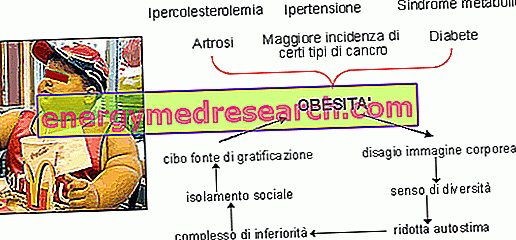Scourge or Eyelashes
The flagellum is an organ of locomotion typical of cylindrical bacteria (bacilli).
Depending on the number and position of these flagella, the bacteria are divided into:
 | MONOTRICHI |  | peritrichous |
| LOFOTRICHI | ANFITRICHI |
The flagella - whose length is between 5 and 10 micrometers - have a filamentous structure and consist of helical protein subunits containing flagellin (a protein). Thanks to these proteins, which differ from bacterium to bacterium by amino acid constitution, the flagella represent organs of recognition for the human immune system (they constitute the so-called ANTIGENE H).

In each scourge three parts can be recognized:
- the filament, which is the protruding portion
- a hook, through which it attaches to the plasma membrane
- a basal body, which acts as an anchorage to the membrane
Inside the basal body is generated the energy necessary to make the flagellum move counterclockwise or clockwise. In the first case - considering that the helix formed by the flagellin has a left-handed trend - an active propulsive movement ("swimming", positive chemotaxis) is generated, while when the flagellum moves clockwise there is an unproductive movement. The orientation of the movements is influenced by the stimuli picked up by the receptors placed on the surface of the bacterium; if these perceive the presence of nutrients, an active propulsive movement is generated; vice versa, if the captured signal is harmful (for example due to the presence of antibacterial substances), there is negative chemotaxis and the bacterium moves away.
The active mobility, given to the cell by the presence of flagella, can also favor the penetration of pathogens into the body.
Pili or Fimbrie
Much smaller than flaggelli (they have dimensions of 0.2 - 2 micrometers), they consist of a repetition of protein subunits forming a helical structure. They appear as filamentous appendages, have no function of movement and are more frequent in negative GRAM species, both mobile and immobile.
The proteins that compose them are called pilines, while those that characterize their extremities are called adhesins; the latter allow the bacterium to adhere better to surfaces, such as the mucous membranes of the human organism.
Then there are particular types of fimbriae, called FIMBRIE F (F as Fertility), without adhesins and involved in the conjugation process.
Summing up, therefore, there are sexual pili and pili with adhesive properties.
Bacterial capsule
The bacterial capsule is a very voluminous shell consisting essentially of water and mucopolysaccharides, which give it a certain stickiness. Promotes the adhesion of the bacterium to certain surfaces or other bacteria (facilitating the formation of colonies); it also has an important anti-phagocytic and protective function against antibacterial substances, such as lysozyme itself.
Thickness, density and adherence of the capsule to the cell wall vary from species to species.
Crystalline layer
O layer S; It consists of proteins and polymers of various kinds, which bind together in an orderly manner. It has a protective function and promotes bacterial aggregation and adhesion to mucous surfaces.
spore
Spore is typical of many bacteria, especially those belonging to the genus Bacillus or Clostridium. When a bacterial cell enters a phase of metabolic latency due to the lack of conditions suitable for life (lack of nutrients, excessively high or low temperatures, etc.), it surrounds its DNA with a series of protective structures (bark, mantle and exosporum) and expels it. Thanks to this sort of extremely resistant shell, the spore can survive particularly unfavorable environmental conditions (such as cooking food) and reactivate - with a process called germination - as soon as they are suitable for life.
The process of sporulation (that is spore formation) lasts from six to ten hours and is mediated by genetic activations in response to environmental changes; to germinate, on the other hand, the spore takes an average of one or two hours.



